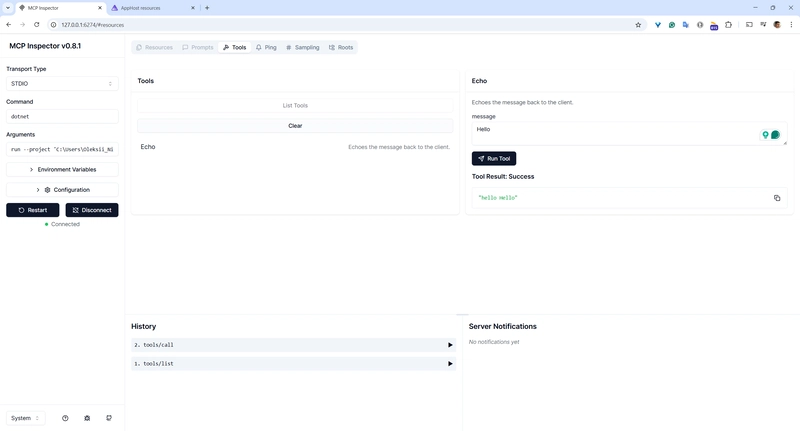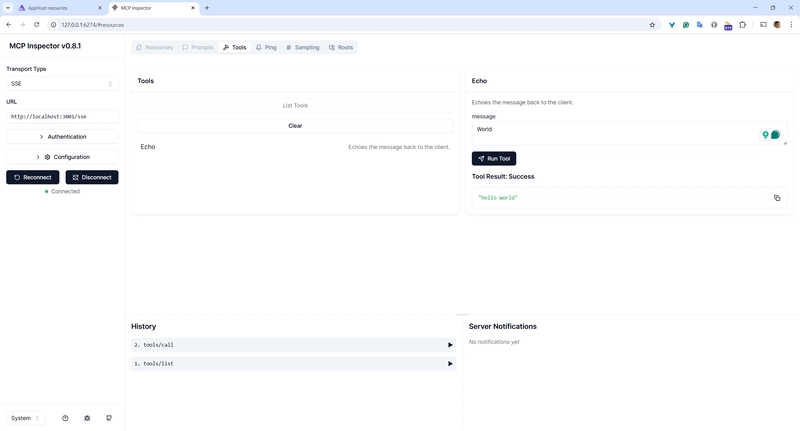
TL;DR
You can use Nall.ModelContextProtocol.Inspector.Aspire.Hosting hosting integration to run MCP Inspector and integrate it with your MCP Servers using Aspire.
Source code: https://github.com/NikiforovAll/mcp-template-dotnet
Introduction
This blog will be in a form of tutorial, we will build a simple echo MCP server by using Nall.ModelContextProtocol.Template template that I’ve shared with you in the previous post.
🚀 Let’s get started. I want to demonstrate two ways (aka Transports) to run the MCP server: stdio and sse.
But first, let’s create Aspire project.
➕ Create AppHost:
dotnet new aspire-apphost -n AppHost -o AppHost
📦 Install Nall.ModelContextProtocol.Inspector.Aspire.Hosting package:
dotnet add ./Apphost package Nall.ModelContextProtocol.Inspector.Aspire.Hosting
📦 As in my previous post, let’s install Nall.ModelContextProtocol.Aspire.Template package:
dotnet new install Nall.ModelContextProtocol.Template
# These templates matched your input: 'mcp'
# Template Name Short Name Language Tags
# -------------- -------------- -------- -------------
# MCP Server mcp-server [C#] dotnet/ai/mcp
# MCP Server SSE mcp-server-sse [C#] dotnet/ai/mcp
‘Stdio’ Mode
➕Create an MCP server:
dotnet new mcp-server -o MyAwesomeMCPServer -n MyAwesomeMCPServer
🔗 Add project reference to AppHost:
dotnet add ./AppHost/AppHost.csproj reference ./MyAwesomeMCPServer/MyAwesomeMCPServer.csproj
In Program.cs of the AppHost, add the following code:
var builder = DistributedApplication.CreateBuilder(args);
builder.AddMCPInspector().WithStdio<Projects.MyAwesomeMCPServer>();
builder.Build().Run();
It run’s @modelcontextprotocol/inspector under the hood. It is an MCP proxy that allows you to test and debug MCP servers.
💡 Note: The Inspector is responsible for starting the .NET project. So, no corresponding Aspire Resource will be available on the dashboard for the ‘Stdio’ mode.

Open http://127.0.0.1:6274 in your browser and click “Connect.”. Now, you can test the server using the Inspector tool.

‘SSE’ Mode
Let’s generate a new MCP server using the sse transport. You can learn more about MCP transports here - https://modelcontextprotocol.io/docs/concepts/transports
➕ Create a new MCP server:
dotnet new mcp-server-sse -o MyAwesomeMCPServerSSE -n MyAwesomeMCPServerSSE
🔗 Add project reference to AppHost:
dotnet add ./AppHost/AppHost.csproj reference ./MyAwesomeMCPServerSSE/MyAwesomeMCPServerSSE.csproj
In Program.cs of the AppHost, add the following code:
var builder = DistributedApplication.CreateBuilder(args);
var mcp = builder.AddProject<Projects.MyAwesomeMCPServerSSE>("server"); // NOTE, for SSE mode it's a separate project
builder.AddMCPInspector().WithSSE(mcp);
builder.Build().Run();
The Aspire Dashboard looks slightly different for the sse mode. Because, this approach creates a separate Aspire.Hosting.ApplicationModel.ProjectResource with an exposed /sse endpoint. This endpoint allows you to seamlessly connect to the MCP server using the Inspector tool.

Open http://127.0.0.1:6274 in your browser and click “Connect.”. Now, you can test the server using the Inspector tool.

⚠️ As for now, it is not possible to specify sse endpoint in the Inspector command line to automatically configure MCP Inspector. I plan to extend the Aspire integration when the feature will be implemented - modelcontextprotocol/inspector/issues/239. For now, you have to configure the Inspector manually if you divert from standard configuration.
Stdio vs SSE
I demonstrated two approaches to running MCP servers. Personally, I favor the sse mode due to its transparency and ease of troubleshooting. For instance, you can launch an MCP server with a debugger attached or view the output logs directly. In contrast, the stdio mode relies on the Inspector to start the server, which disables logging on the MCP server to maintain compatibility with the Inspector.
Conclusion
I hope this blog post has provided you with a clear way to start building your own MCP servers using the Aspire hosting integration.
🙌 I hope you found it helpful. If you have any questions, please feel free to reach out. If you’d like to support my work, a star on GitHub would be greatly appreciated! 🙏


Top comments (0)